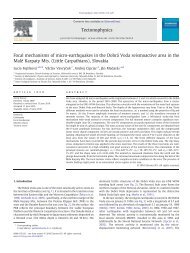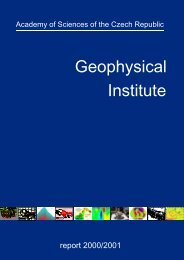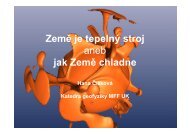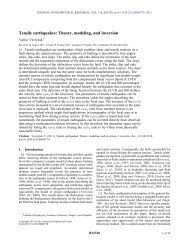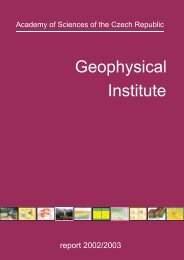Geophysical Institute of the ASCR
Geophysical Institute of the ASCR
Geophysical Institute of the ASCR
Create successful ePaper yourself
Turn your PDF publications into a flip-book with our unique Google optimized e-Paper software.
<strong>the</strong> paleoclimate evolution <strong>of</strong> up to several past<br />
centuries. In <strong>the</strong> last 10 – 15 years <strong>the</strong><br />
inversion technique to infer <strong>the</strong> climate history<br />
from temperature-depth records became a<br />
useful alternative method <strong>of</strong> general<br />
paleoclimate reconstruction studies.<br />
The inversion results from almost 100<br />
boreholes from <strong>the</strong> Czech territory were<br />
interpreted and <strong>the</strong> past climate scenario<br />
proposed for <strong>the</strong> last millennium reflecting<br />
also some regional characteristics (Čermák<br />
and Bodri, 1999, Šafanda et al., 1997). As<br />
a continuation <strong>of</strong> <strong>the</strong>se studies three<br />
experimental sites were selected to monitor<br />
shallow subsurface temperature-time variations<br />
to quantitatively assess <strong>the</strong> magnitude <strong>of</strong> <strong>the</strong><br />
present-day (global) warming. In 2004 two<br />
research projects have been solved, both<br />
addressing <strong>the</strong> air-soil temperature coupling<br />
and <strong>the</strong> possibility to distinguish between <strong>the</strong><br />
natural and anthropogenic components <strong>of</strong> <strong>the</strong><br />
warming. The main objectives <strong>of</strong> <strong>the</strong> GAAV<br />
grant A3012005 “Recent Climate Change and<br />
Its Contingent Component Revealed by<br />
Inversion <strong>of</strong> Present Temperature Data<br />
Measured in Boreholes” (2000 – 2004) covered<br />
year-long temperature monitoring in two <strong>of</strong><br />
<strong>the</strong>se sites up to 40 m depth to complete <strong>the</strong><br />
inverted ground surface temperature histories<br />
(GSTHs) by information on <strong>the</strong> regional trends<br />
Fig. 4. Monitoring results from <strong>the</strong> Spořilov hole<br />
demonstrating <strong>the</strong> gradually diminishing surface<br />
“climate” signal with depth.<br />
and to correlate <strong>the</strong> results with meteorological data. The GAČR grant „Climate Change and Global<br />
Warming – Evidence From <strong>the</strong> Underground“ (2003 – 2005) completed <strong>the</strong> previous investigations by<br />
a new observational site, located in one <strong>of</strong> <strong>the</strong> most environmentally polluted area <strong>of</strong> <strong>the</strong> Krušné Hory<br />
Mts., where <strong>the</strong> maximum warming rate should be observed supposedly.<br />
The important part <strong>of</strong> <strong>the</strong> paleoclimate investigations are <strong>the</strong> studies <strong>of</strong> <strong>the</strong> time succession <strong>of</strong> <strong>the</strong><br />
climate extremes and <strong>of</strong> <strong>the</strong> high-frequency climate variation. The knowledge <strong>of</strong> <strong>the</strong> existing climate<br />
variability can help in <strong>the</strong> climate prognosis, e.g. in <strong>the</strong> estimate <strong>of</strong> <strong>the</strong> number <strong>of</strong> climate extremes<br />
and <strong>the</strong>ir tendency to grow or fall. The climate models incorporating <strong>the</strong> increasing concentration <strong>of</strong><br />
<strong>the</strong> green-house gases suggested that <strong>the</strong> present climate warming might be connected with <strong>the</strong><br />
decreasing high frequency temperature variability. The monitoring temperature results from both<br />
experimental boreholes were used to assess <strong>the</strong> variability at several selected frequencies, when <strong>the</strong><br />
absolute differences between <strong>the</strong> mean temperature anomalies at various intervals were taken as <strong>the</strong><br />
variability measure (Bodri and Čermák, 2003b).<br />
19




